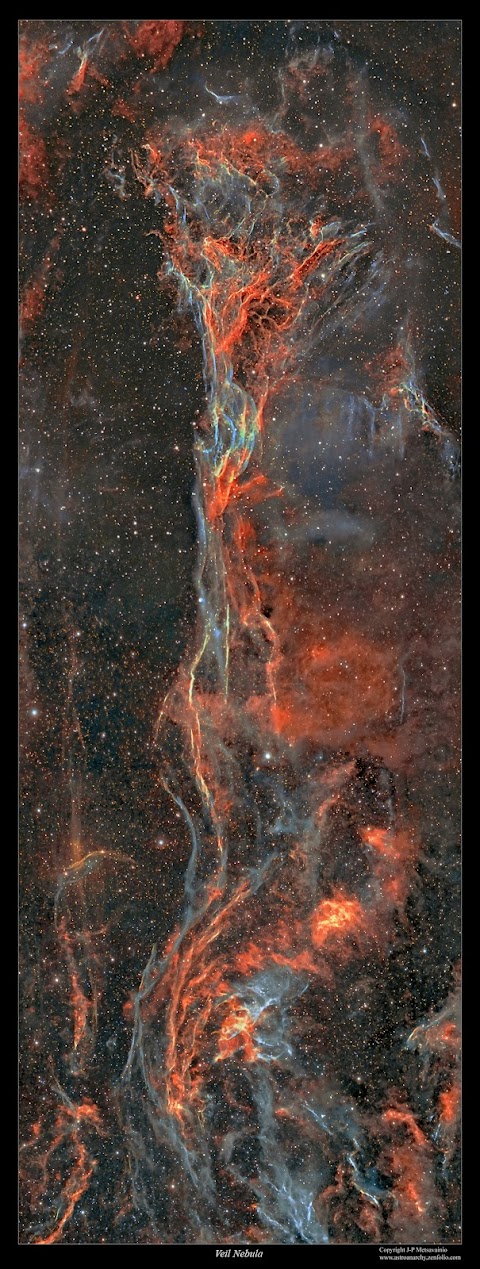COPYRIGHT, PLEASE NOTE
Thursday, September 30, 2021
Filaments of Veil Nebula SNR
I shot most of the lights for this image back in 2016, now I have added some new material to it and reprocessed the whole image. An older mapped color version can be seen here, https://astroanarchy.blogspot.com/2016/12/filaments-of-veil-nebula.html
Photo was shot with a Celestron Edge HD 11" telescope, Astrodon naarrow band filters and Apogee Alta U16 astro camera. New data is shot with a shorter focal length instrument, Tokina AT-x 300mm f2.8 camera lens, same camera and filters. Dim background emission is taken from a new material and added to this photo.
Total exposure time is now 44 hours for the whole three frame mosaic and the resolution is 11.000 x 4000 pixels.

Image is in visual palette from emission of an ionized elements, hydrogen (H-alpha), sulfur (S-II) and oxygen (O-III). Red=Hydrogen + 33% sulfur, Green=oxygen and Blue=oxygen + 33% hydrogen to compensate otherwise missing H-beta emission.
A closeup
Click for a large image
Every single pixel in this 3d-animation is from the original 2D-image above. The model is based on on known scientific facts, deduction and some artistic creativity. The result is an appraised simulation of reality. Astronomical photos are showing objects as paintings on a canvas, totally flat. In reality, they are three dimensional forms floating in three dimensional space. The purpose of my 3d-experiments is to show that and Give an idea, how those distant objects might look in reality. More info about my 3D-technique at end of this blog post: https://astroanarchy.blogspot.com/2021/10/unveiling-veiled.html
NOTE. It looks like that the animation has less stars, than the original 2d-image. That's not true, stars is normal photo are getting projected to a same plane. In 3D-model stars are in volume and it only looks like, that there are less stars.
Tuesday, September 28, 2021
Veil nebula unveiled II
I haven't start the imaging season yet, up here 65N. Nights are still short and I haven't got my imaging rig ready after the mandatory six months Summer break.
I have reprocessed some older shots with new data, this time the Veil nebula supernova remnant in Cygnus. Original image was shot with the Canon EF 200 mm f1.8 camera optics full open, QHY9 astro camera and Baader narrowband filters at 2013.
New data is shot with Tokina 300mm f2.8 camera optics and Celestron Edge HD 11" telescope, Apogee Alta U16 astro camera with Astrodon narrowband filters.
Total exposure time is now about 45 hours. I published yesterday a Pickering's Triangle photo taken with Celestron Edge HD 11"-. It's part of this new image among other.
Veil nebula Unveiled
Click for a large image, 1250 x 1700 pixels
https://astroanarchy.blogspot.com/2013/12/veil-nebula-unveiled.html
Monday, September 27, 2021
Pickering's Triangle in Visual palette
I have reprocessed some older data and made a new composition out of it. Pickering's Triangle is part of the Veil nebula supernova remnant in constellation Cygnus. It has an amazing structure of complex gas filaments. This image is one of the most detailed presentations, showing the whole triangle shape formation, I have seen so far.
Image is in visual palette from emission of an ionized elements, hydrogen (H-alpha), sulfur (S-II) and oxygen (O-III). Red=Hydrogen + 33% sulfur, Green=oxygen and Blue=oxygen + 33% hydrogen to compensate otherwise missing H-beta emission. (H-beta and H-alpha has a same shape but H-beta is weaker. H-alpha emits red light and H-beta emits blue light.) Exposure time ~20 hours.
here you can see ta mapped color image from same data, https://astroanarchy.blogspot.com/2021/08/pickerings-triangle-reprocessed-with.html
click for a large image
A Closeup
click for a large image
Orientation in Veil nebula SNR
click for a large image
Tuesday, September 21, 2021
Supernova Remnant Simeis 147, new data added
I have made a new version of my NASA APOD and National Geographic Image of the Week photo. Simeis 147 is a large and very dim supernova remnant in constellation Taurus.
I combined an old data with a new data, with different optics and camera, together.
As a result I have more details, vivid colors and better overall signal in the new photo. An
older photo is from 2011 and the new photo from 2020. Total exposure time in this new composition is over 45 hours.
Simeis 147 SNR
Click for a large image, 1700 x 1200 pixels
An Experimental Starless Version
How long it'll takes to this supernova remnant to expand 1% large when the diameter is 160 light years and it expands at speed of 1000 km/second.
(1% of diameter 160/100= 16, as kilometers ~151.372.800.000.00, = Y, km,
1000 km/second is ~315.360.000.00, = Z, kilometers/year.
So, X x Z = Y and X=Z/Y, X = 480 years with given values)
Every single element in Vision series photos are from my original astronomical photos. I have been using the Overlapping Lightning Method (Multi Exposure Method) to create my Vision series photographs. By this method the forms and structures in astronomical object get multiplied, they are now forming a new visual dimension beyond our physical universe.
Photo from 2011
H-alpha 42x1200s, binned 1x1





















